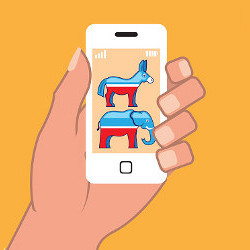
When people are asked whom they will vote for, they might not want to say. After all, other people might judge them, ask for contributions, or publish the answer. Suppose there are two candidates, randomly called B and T. Suppose, again for the sake of this hypothetical, that there is a slight stigma against people who support T.
The pollster says to them: “Please flip a coin. If the coin comes up tails, please tell us whom you like best. If it comes up heads, then always say T.” That way, even if a person states an intention to vote for T, nobody knows for sure.
Warm-Up: Suppose the true probabilities are 60% for B and 40% for T. 200 people are again polled. How many will say T in response to the poll with the coin-flip rule and how many will say B?
Solution to Warm-Up: Approximately half the people—100—will flip heads and will say T, regardless of their preferences. Of the other half—60—will say B and 40 will say T. So 140 will say T and 60 will say B.
Warm-Up 2: Suppose 70% want T and 30% want B. 200 people are again polled. How many will say T in response to the poll with the coin-flip rule and how many will say B?
Solution to Warm-Up 2: 170 for T and 30 for B. So to find the true support for T and B, simply subtract from the T score half of the total number of people polled. Leave the B score alone.
But now suppose a country is so divided that, depending on whom you talk to, there might be a stigma to vote for either candidate. Can the pollsters still do their job?

Figure. Political pollster: “We understand your choice of candidate may be something you want to keep private. At the end of this process, only you will know for sure whether the choice you mention is your real choice or not.”
Question: Can you think of a protocol that will protect privacy for supporters both of B and T?
Solution: Here is one possibility. Tell the pollees (the people asked): “Please flip a coin twice. If it comes up heads both times, then please say T. If it comes up tails both times, please say B. With any other combination, please tell us the truth.” Suppose again for the purposes of example 60% want B and 40% want T. If 200 people are polled, B will get 60 true answers and 50 because of double tails. The remaining 90 will go to T. Thus, we subtract a quarter of the total number of people polled (50 in this example) from B (yielding 110−50 = 60), a quarter from T (yielding 90−50 = 40) and we get the correct answer.
The only trouble with this privacy-preserving approach is that it requires doubling the number of people polled to get the same effective sample size. In terms of this example, 200 people must be sampled to get an effective sample size of 100.
Question: Suppose T has the support of approximately 60% of the people and B has the support of 40%. Suppose the stigma is against only B supporters. Assuming the people who are polled are given a standard deck of 52 playing cards, can you make it so that if a per-son responds B, then that person has approximately a 50% chance of actually supporting B and achieve an effective sample size of 100 by polling only 140 people?
Solution: Suppose that with probability 2/7 a person will say B regardless of his or her view. Then if 60% want T and 40% want B, B will receive (2/7)*140 = 40 votes because of this 2/7 probability and another 40 from the committed B supporters. Such a scheme would have the goal of having anyone who responds with B to the pollster to have a 50% chance of supporting B. To achieve this, the pollster says to the pollee: “Please take seven cards including an Ace, 2, 3, 4, 5, 6, and 7, regardless of suit. Shuffle the seven cards. Now turn over one card. If it is an Ace or a 7, say B. Otherwise, please tell me what you really think.” In this way, only 40 extra people must be interviewd to get an effective sample size of 100 or in general 2/7 extra people.
Upstart: Generalize the above solution to k candidates all with approximately equal support. Each person should have a probability of no more than p of actually supporting the candidate he or she mentions. You can assume for this purpose the pollee has access to a trusted random number generator that will give a number between 0 and 1 with uniform probability. It should be enough to use this random number generator just once per pollee.



Join the Discussion (0)
Become a Member or Sign In to Post a Comment